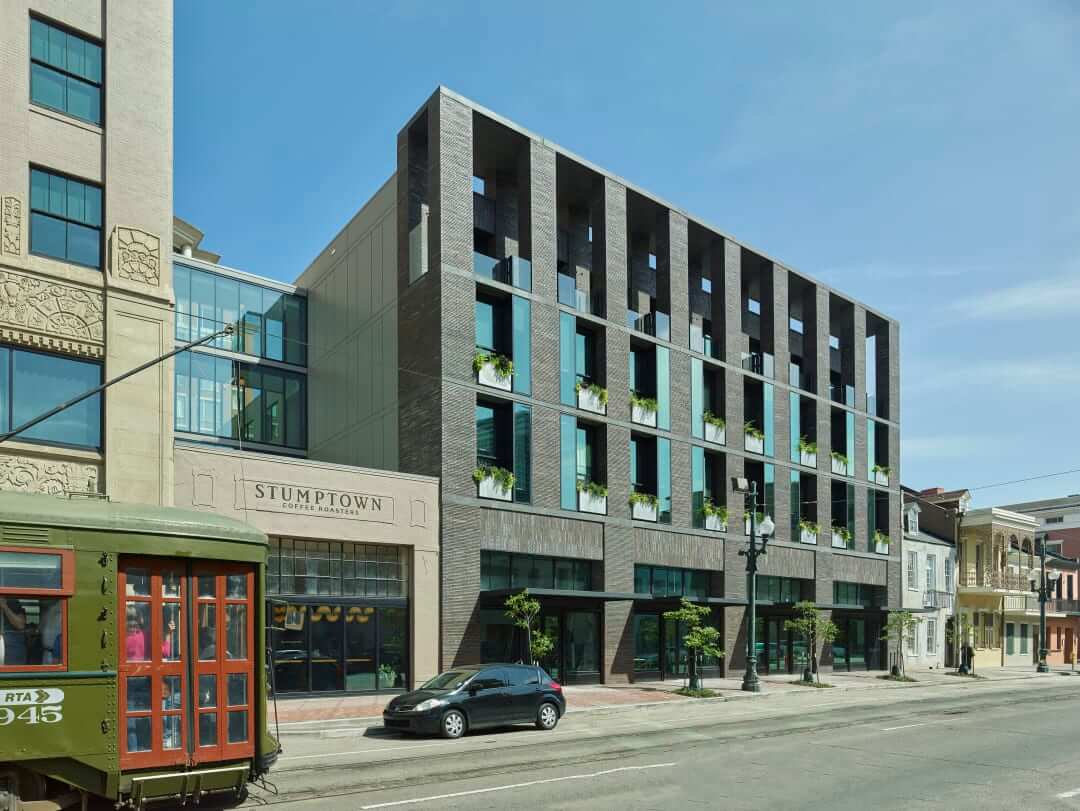By AIA Contract Documents, March 5, 2020

The Ace Hotel was renovated and restored into a mixed-use hotel, retail and event center in the heart of New Orleans.
Located in the heart of New Orleans’ Warehouse District, the beautiful Ace Hotel New Orleans stands as a symbol of historic preservation and modern functionality. The nine-story Art Deco building, first constructed in 1928, was renovated and restored into a mixed-use hotel, retail and event center that retains its bold architectural character.
Through tight teamwork and collaboration, the owner and project team completed the project in an impressive 14-month build window, thanks largely to teamwork, comprehensive community engagement and responsible risk allocation.
Domain Companies, the national development and real estate investment company that facilitated the Ace Hotel renovation and restoration, selected Eskew+Dumez+Ripple as the architect for the project through a competitive, qualifications-based process.
Familiar with the owner from past projects, the architect knew the key touchpoints in terms of ownership, core values, price competitiveness and risk consciousness.
Tracy Lea, Principal with Eskew+Dumez+Ripple, explained the importance of this familiarity in the context of intellectual property, adding, “Many clients and building owners don’t really understand the subtleties of intellectual property ownership, often likening it to purchasing a product off the shelf. There is a big difference and not all contract documents make that clear. Standard agreements have language to protect the architect’s rights and still give owners the necessary information they need to construct a project without infringing on the architect’s ownership of the intellectual property.”
In this case, the owner relied on the AIA B101, Owner/Architect agreement.
Domain also contracted the joint venture team of Broadmoor LLC and Palmisano Contractors as the construction manager through a qualification-based selection process, using the A201®,General Conditions and the A133, Owner/Construction Manager as Constructor Cost of the Work Plus a Fee with a Guaranteed Maximum Price.
Those documents set up a collaborative, risk balanced arrangement that would help guide the owner and project team through the build process, even during unanticipated events on the almost 100-year-old structure.
“Many clients enter into a design project, thinking that all they need to give an architect or designer to start is a very simple explanation of what they want,” adds Lea. In some cases, that information is just a list of rooms with square footage. But there’s a lot more information that needs to be understood by the designer to begin development of the concept. The process must begin with a clear understanding of the client’s goals.
Lea explained, “Simply leading the client through the act of articulating what their goals are for the project can really inform the design and affect the outcome for the better. As a policy, our particular methodology always involves a period of discovery before we start designing, which we call project definition. For us, that’s more than programming—which is more about the size of space, relationships and design influences.”
The Lobby Bar serves up beautiful cocktails with a French Deco-inspired living room vibe.
As often happens in historic renovations, change occurs during construction due to unforeseen or unknown circumstances. The Ace Hotel project was no different. In one instance, during the process an opportunity came up for the developer to acquire an adjacent piece of property.
“Our job was to help them find the best use for that piece of property without impacting the proforma work that had already been completed and their economic projections,” Lea noted.
The owner looked to turn the small piece of property into a retail opportunity, which required some conceptual changes to the design and circulation of the building.
“The addition required some significant adjustments, which were considerably easier because of the AIA change order and contract modification documents,” added Lea. “Everything turned out great and the new addition, especially the coffee shop, is a nice complimentary accessory to the hotel and the hotel restaurant.”
Lea said that one outcome of the project that the firm and owner were most pleased is the way the architect was able to blend the new construction part of the project. Lea concluded, “We were able to maintain integrity as a contemporary design, while at the same time, make it compatible with and complimentary to the historic brand renovation.”
The Ace Hotel New Orleans was completed in 2016.